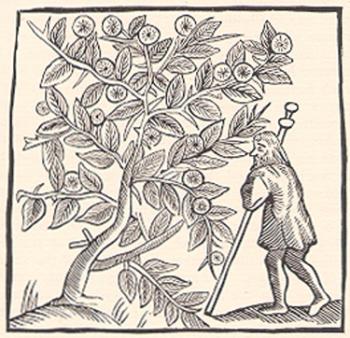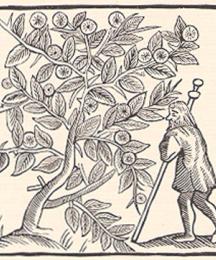Located in Somerset, Glastonbury is the focal point for a number of legends and stories relating to Arthur and the Grail and is sometimes equated with the Island of
Avalon, an association that is bolstered by the fact that the marshy lands of the region made Glastonbury virtually an island in its early history. The site of a medieval abbey and perhaps a sacred site even before the coming of Christianity to Britain, Glastonbury was, according to tradition, the first Christian settlement in Britain. By some legendary accounts, Christianity at Glastonbury can be traced back to Joseph of Arimathea. In his fifteenth-century translation of the Vulgate
Estoire del Saint Graal, Henry Lovelich asserts that Joseph of Arimathea was buried at Glastonbury.
In
The Antiquities of Glastonbury (ca. 1135), William of Malmesbury explains that the name of Glastonbury came from a British king named Glasteing, who followed a sow until he found her under an apple tree; hence he called the place ‘Insula Avallonia’ or ‘Apple Island’ (‘avalla’ meaning ‘apple’). William also offers the alternate explanation that Avallonia derives from Avalloc, a man who lived there with his daughters. According to William, the island was first called Ynyswitrin by the British and then Glastinbiry by the Angles, which he considers either the translation of Ynyswitrin or a name derived from Glasteing.
In his
Life of Gildas (ca. 1130), Caradoc of Llancarfan reports that Glastonbury was called Ynisgutrin, Island of Glass, by its original British inhabitants but that the English renamed it Glastigberi, the City of Glass. Caradoc...
Read More
Read Less
Located in Somerset, Glastonbury is the focal point for a number of legends and stories relating to Arthur and the Grail and is sometimes equated with the Island of
Avalon, an association that is bolstered by the fact that the marshy lands of the region made Glastonbury virtually an island in its early history. The site of a medieval abbey and perhaps a sacred site even before the coming of Christianity to Britain, Glastonbury was, according to tradition, the first Christian settlement in Britain. By some legendary accounts, Christianity at Glastonbury can be traced back to Joseph of Arimathea. In his fifteenth-century translation of the Vulgate
Estoire del Saint Graal, Henry Lovelich asserts that Joseph of Arimathea was buried at Glastonbury.
In
The Antiquities of Glastonbury (ca. 1135), William of Malmesbury explains that the name of Glastonbury came from a British king named Glasteing, who followed a sow until he found her under an apple tree; hence he called the place ‘Insula Avallonia’ or ‘Apple Island’ (‘avalla’ meaning ‘apple’). William also offers the alternate explanation that Avallonia derives from Avalloc, a man who lived there with his daughters. According to William, the island was first called Ynyswitrin by the British and then Glastinbiry by the Angles, which he considers either the translation of Ynyswitrin or a name derived from Glasteing.
In his
Life of Gildas (ca. 1130), Caradoc of Llancarfan reports that Glastonbury was called Ynisgutrin, Island of Glass, by its original British inhabitants but that the English renamed it Glastigberi, the City of Glass. Caradoc identifies it as the place where Melvas, king of the summer country, had his stronghold, to which he brought Arthur’s queen after abducting her.
In 1190 or 1191, Arthur’s grave was said to have been found at Glastonbury. Giraldus Cambrensis records in his
De Principis instructione (1193) that Arthur was buried deep in the earth in a hollowed oak tree between two stone pyramids. A lead cross in the tomb contained an inscription declaring that the famous King Arthur and his wife Guinevere were buried here on the Island of Avalon. Other accounts of the lead cross—that, for example, by John Leland, who claims to have seen the cross—do not add Guinevere to the transcription (though Leland’s report, like that of Giraldus, does record that her body was discovered in the tomb and that a lock of her golden hair crumbled to dust when touched by a monk). In literary accounts of Arthur’s death, he is often buried at Glastonbury.
Glastonbury is also known for its connection to the Holy Grail, fostered by the link to Joseph of Arimathea, who in some accounts led the expedition that brought the Grail to Britain. Among the legends associated with Glasotonbury is that of the Holy Thorn. An eighteenth-century chapbook,
The History of That Holy Disciple Joseph of Arimathea, tells that when Joseph planted his staff on a hill at Glastonbury, it sprouted into a thorn tree which continues to bloom each year on Christmas Day.
The association with the Grail and with ancient spirituality has made Glastonbury a center for people with traditional and non-traditional spiritual views. Dion Fortune, author of
Avalon of the Heart (1934), suggested that Glastonbury can be approached not only through history and through legend but also through ‘the Mystic Way’, which leads to the ‘Avalon of the Heart’; and she spoke of Glastonbury as ‘a gateway to the Unseen’. In her book
The Mists of Avalon (1982), Marion Zimmer Bradley uses a similar scheme of an historical Glastonbury co-existing with another realm called Avalon.
BibliographyAshe, Geoffrey. King Arthur's Avalon: The Story of Glastonbury. London: Collins, 1957.
Carley, James P. Glastonbury Abbey: The Holy House at the Head of the Moors Adventurous. New York: St. Martin's Press, 1988.
Glastonbury Abbey and the ARthurian Tradition. Ed. James P. Carley. Cambridge:L D. S. Brewer, 2001.
A Glastonbury Reaser: Selections from the Myths, Legends and Stories of Ancient Avalon. Ed. John Matthews. London: The Aquarian Press, 1991.
Kennedy, Edward Donald. "Glastonbury." In The Arthur of Medieval Latin Literature: The Development and Dissemination of the Arthurian Legend in Medieval Latin. Ed. Siân Echard. Cardiff, Wales: University of Wales Press, 2011. Pp. 109-31.
Lagorio, Valerie M. "The Glastonbury Legends and the English Arthurian Grail Romances." Neuphilologische Mitteilungen 79 (1978), 359-66.
Robinson, J. Armitage. Two Glastonbury Legends: King ARthur and St Joseph of Arimathea. Cabridge: Cambrige University Press, 1926.
Treharne, R. F. The Glastonbury Legends: Joseph of Arimathea, The Holy Grail and King Arthur. London: The Cresset Press, 1967.
Watkin, Aelred. "The Glastonbury Legends." Arthurian Literature 15 (1997): 77-91.
Wood, Juliette. "The Grail at Glastonbury." Chapter 2 of Eternal Chalice: the Enduring Legend of the Holy Grail. Londin: I. B. Tauris, 2008. Pp. 29-52.
Read Less






